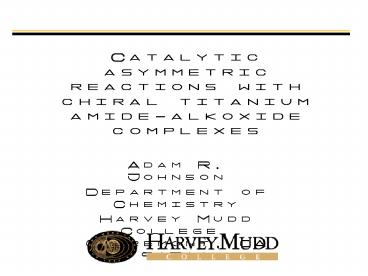Catalytic asymmetric reactions with chiral titanium amidealkoxide complexes - PowerPoint PPT Presentation
1 / 15
Title:
Catalytic asymmetric reactions with chiral titanium amidealkoxide complexes
Description:
Alkylation data highlights. 85-98% conversion; some reduction ... Complex 5b is more soluble, only 35% yield. Thermolysis gives new product/decomposition ... – PowerPoint PPT presentation
Number of Views:110
Avg rating:3.0/5.0
Title: Catalytic asymmetric reactions with chiral titanium amidealkoxide complexes
1
Catalytic asymmetric reactions with chiral
titanium amide-alkoxide complexes
- Adam R. Johnson
- Department of Chemistry
- Harvey Mudd College, Claremont, CA 91711
2
Modular ligand synthesis
1st generation, R H 2nd generation, R alkyl
3
Ligand nomenclature
1st generation
2nd generation
2nd generation
2nd generation
2nd generation
2nd generation
Cant be made
4
Initial hydroamination results
10 mol cat., 110 C
10 mol cat., 135 C
1st generation ligands ees by chiral GC of
benzamide derivative blue ees are opposite
enantiomer (lower Rf found with D-ligands)
Organometallics, 2004, 4614
5
Hydroamination with 2nd generation ligands
5 mol cat., 135 C Overnight reaction, gt95
completion, single product
2nd generation ligands ees by chiral shift NMR
using R-O-acetylmandelic acid red isomers
(more downfield shift) correspond to same
enantiomer as before (longer Rf by GC)
6
Benzaldehyde alkylation
- -78 to room temperature overnight
- Same reaction conditions for titanium complexes
- 1.1 eq Et2Zn
- 5 mol ligand
- 5 mol Ti(OiPr)4
7
Alkylation data highlights
- 85-98 conversion some reduction
- R product favored with L-amino alcohols
- Increase in ee using Ti, but same enantiomer (in
almost all cases)
8
Data
9
New directions
- Sulfonamides
- Tridentate ligands
Electron withdrawing
More rigidity
10
Sulfonamide ligands
- Electron withdrawing ligands
- Faster rate would allow for lower T and increase
ee
At 95 C
At 135 C
At 110 C
11
TiCl2(NMe2)2 starting material
- Precipitates quantitatively (for 5a 92 isolated)
and analytically pure from reaction mixture - insoluble Et2O, C6H6, C7H8 soluble in thf,
CH2Cl2 - Complex 5b is more soluble, only 35 yield
- Thermolysis gives new product/decomposition
- 1H NMR spectrum incompatible with monomer
Inorg. Chim. Acta, 2005, 358, 687
12
Low T Limit 11 C
CH(CH3)2
No change in spectrum down to -56 C
NCH3
NH
CH(CH3)2
13
(No Transcript)
14
Dynamic NMR Behavior
- Deuterated derivatives to simplify spectra
- VT NMR used to determine first order rate
constants - ?H 16-20 kcal/mol
- ?S 2-16 e.u.
Proposed dynamic model
15
Acknowledgements
- ACS-PRF, NSF-RUI, NSF-REU
Undergraduate co-workers Benzaldehyde
alkylation Casey M. Jones (Reed, 05), Hanhan
Li (HMC, 05), Joanne E. Redford (HMC 09), Sam
J. Sobelman (HMC 08), J. Andrew Kouzelos (HMC
07), Ryan J. Pakula (HMC 09) Hydroamination
Amanda J. Hickman (HMC 07), Lauren D. Hughs (HMC
09) New directions Dianna C. McAnnally-Linz
(Agnes Scott, 08), Katie E. Near (10), Minh T.
Nguyen (U. La Verne, 08), Andrew H. Stewart
(HMC, 08), Camille M. Sultana (HMC, 10)































